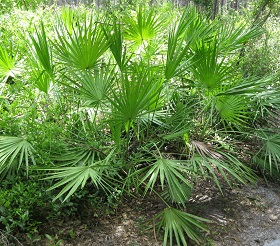
by Sheila Dunning | Jun 3, 2016
According to the Atlas of Florida Vascular Plants, there are more than 4,200 plant species naturally occurring in the state. Nearly 3,000 are considered native. The Florida Native Plant Society (FNPS) defines native plants as “those species occurring within the state boundaries prior to European contact, according to the best available scientific and historical documentation.” In other words, the plants that grew in natural habitats that existed prior to development.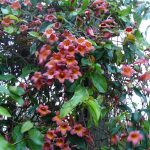
Native plants evolved in their own ecological niches. They are suited to the local climate and can survive without fertilization, irrigation or cold protection. Because a single native plant species usually does not dominate an area, there is biodiversity. Native plants and wildlife evolved together in communities, so they complement each other’s needs. Florida ranks 7th among all 50 states in biodiversity for number of species of vertebrates and plants. Deer browse on native vines like Crossvine (Bignonia capreolata), Trumpet Creeper (Campsis radicans), Yellow Jessamine (Gelsemium sempervirens) and Trumpet Honeysuckle (Lonicera sempervirens). The seeds and berries of Black-eyed Susan (Rudbeckia fulgida), Flowering Dogwood (Cornus florida) and Dahoon holly (Ilex cassine) provide vital food for songbirds, both local and migratory. Saw palmetto (Serenoa repens) provides cover for numerous birds and small mammals, as well as, reptiles.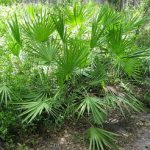
Non-native plants become “naturalized” if they establish self-sustaining populations. Nearly one-third of the plants currently growing wild in Florida are not native. While these plant species from other parts of the world may provide some of the resources needed by native wildlife, it comes at a cost to the habitat. These exotic plants can become “invasive”, meaning they displace native plants and change the diverse population into a monoculture of one species. Chinese privet (Ligustrum sinense), Popcorn trees (Triadica sebifera) and Cogongrass (Imperata cylindrica) have changed the landscape of Florida over the past decade. While Water hyacinth (Eichhornia crassipes) and Hydrilla (Hydrilla verticillata) have changed water flow in many rivers and lakes. These invasive species cost millions of taxpayer dollars to control.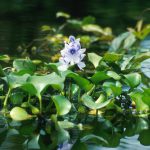
By choosing to use native plants and removing non-native invasive plants, individuals can reduce the disruptions to natural areas. For more information one specific native plants that benefit wildlife go to: http://edis.ifas.ufl.edu/uw384
It learn which plants are invasive go to: http://www.fleppc.org/list/2015FLEPPCLIST-LARGEFORMAT-FINAL.pdf
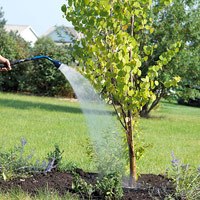
by Sheila Dunning | Jan 23, 2016
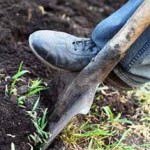 The best time to plant a tree is twenty years ago. The second best time is for Arbor Day. Florida recognizes the event on the third Friday in January, but planting any time before spring will establish a tree quickly.
The best time to plant a tree is twenty years ago. The second best time is for Arbor Day. Florida recognizes the event on the third Friday in January, but planting any time before spring will establish a tree quickly.
Arbor Day is an annual observance that celebrates the role of trees in our lives and promotes tree planting and care. As a formal holiday, it was first observed on April 10, 1872 in the state of Nebraska. Today, every state and many countries join in the recognition of trees impact on people and the environment.
Trees are the longest living organisms on the planet and one of the earth’s greatest natural resources. They keep our air supply clean, reduce noise pollution, improve water quality, help prevent erosion, provide food and building materials, create shade, and help make our landscapes look beautiful. A single tree produces approximately 260 pounds of oxygen per year. That means two mature trees can 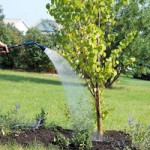 supply enough oxygen annually to support a family of four.
supply enough oxygen annually to support a family of four.
The idea for Arbor Day in the U.S. began with Julius Sterling Morton. In 1854 he moved from Detroit to the area that is now the state of Nebraska. J. Sterling Morton was a journalist and nature lover who noticed that there were virtually no trees in Nebraska. He wrote and spoke about environmental stewardship and encouraged everyone to plant trees. Morton emphasized that trees were needed to act as windbreaks, to stabilize the soil, to provide shade, as well as, fuel and building materials for the early pioneers to prosper in the developing state.
In 1872, The State Board of Agriculture accepted a resolution by J. Sterling Morton “to set aside one day to plant trees, both forest and fruit.” On April 10, 1872 one million trees were planted in Nebraska in honor of the first Arbor Day. Shortly after the 1872 observance, several other states passed legislation to observe Arbor Day. By 1920, 45 states and territories celebrated Arbor Day. Richard Nixon proclaimed the last Friday in April as National Arbor Day during his presidency in 1970.
Today, all 50 states in the U.S. have official Arbor Day, usually at a time of year that has the correct climatological conditions for planting trees. For Florida, the ideal tree planting time is January, so Florida’s Arbor Day is celebrated on the third Friday of the month. Similar events are observed throughout the world. In Israel it is the Tu B Shevat (New Year for Trees). Germany has Tag des Baumes . Japan and Korea celebrate an entire week in April. Even, Iceland one of the treeless countries in the world observes Student’s Afforestation Day.
The trees planted on Arbor Day show a concern for future generations. The simple act of planting a tree represents a belief that the tree will grow and some day provide wood products, wildlife habitat erosion control, shelter from wind and sun, beauty, and inspiration for ourselves and our children.
“It is well that you should celebrate your Arbor Day thoughtfully, for within your lifetime the nation’s need of trees will become serious. We of an older generation can get along with what we have, though with growing hardship; but in your full manhood and womanhood you will want what nature once so bountifully supplied and man so thoughtlessly destroyed; and because of that want you will reproach us, not for what we have used, but for what we have wasted.”
~Theodore Roosevelt, 1907 Arbor Day Message

by Erik Lovestrand | Oct 2, 2015
Anyone who has had a treasured palm tree annihilated by palmetto weevils (Rhynchophorus cruentatus) knows the pain of losing a long-lived tree from the home landscape. These large, native weevils are adept at working unnoticed inside a palm to the point of terminal damage. Typically, by the time you notice that the tree is declining and fronds begin to turn brown there is likely no hope of salvaging the situation. By then the larval grubs have already damaged the tree’s growing bud to the point of no return. At this stage the recommended procedure involves removing the tree, cutting it up and burning it to prevent the invading long-snouted critters from moving over to neighboring palms.
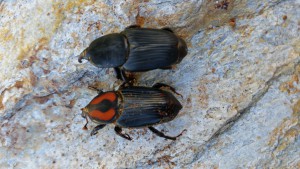
Color and size of adults is quite variable.
However, as frustrating as this is, if we step back and look at the bigger picture it is apparent that even our most aggravating native insect pests are part of the natural web of life and local plants have adapted to survive these “give and take” relationships on the population scale.
Palmetto weevils establish in a new tree when adult females lay their eggs in the crown of the tree and larvae hatch to burrow into the soft terminal bud. It is larval feeding that does the lethal damage. Larvae are large, white, legless grubs that can reach lengths of six-seven centimeters. When larvae are mature they create a cocoon inside the tree from tree fibers and pupate there before hatching into adults to start the cycle over. Grubs can be found in any part of the tree but really need the softer, growing parts for food, such as in the base of the living fronds and the terminal bud.

Weevil damage at base of frond.
The condition created by these burrowers is often referred to as “popped neck,” where the top of a palm tree dies and caves over. If you are in the process of removing a dying or dead palm due to the crown dying it would be a good idea cut through the top section with a chainsaw to see if weevil damage is evident in large (about ½ inch) diameter tunnels. If a live specimen of an adult can be captured in a jar it would be worth a visit to your local Extension office for a positive identification to make sure you aren’t dealing with another similar species of non-native weevil that has not been documented in Florida yet. The red palm weevil (Rhynchophorus ferrugineus) has now been found in the U.S. at Laguna Beach, California. Coloration varies by individual bug but a positive i.d. can be obtained by sending the specimen to UF’s laboratory in Gainesville. For further information on palmetto weevils refer to the EDIS fact sheet at this web link.










